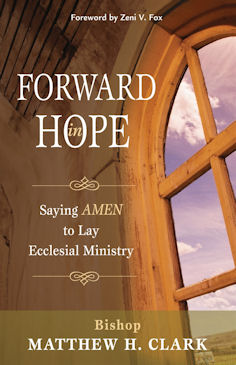
|
Posted August 8, 2014
Book: Forward in Hope: Saying Amen to Lay Ecclesial Ministry Author: Bishop Matthew H. Clark Ave Maria Press. Notre Dame, IN. 2014. Pp. 114 An Excerpt from the Foreword:
History is long, perhaps in the Catholic Church even longer than otherwise, and its perspectives emerge slowly. In this volume, Bishop Matthew Clark presents his own insights about lay ecclesial ministry. These are drawn from the rich personal experience of one who has intimately lived with its historical unfolding, indeed, in his role as bishop, providing leadership for its development. In the telling, we learn much about lay ecclesial ministry and about Bishop Clark, as well as about individual lay ecclesial ministers from his diocese. The encounters are enriching intellectually and spiritually, and give ample evidence of why the title of this volume is Forward in Hope. First, a reflection on the history that is explored. Beginning with scripture, and moving deftly through particular moments of Church history, key developments that led to the evolution of the understandings of ministry prevalent before Vatican II are presented with brevity and clarity. The theological assessment is that, at various junctures in the story, change was suitable for its time, and incremental. The central role of the Second Vatican Council is explored at greater length, with the added dimension of the personal experience of then-seminarian Matthew Clark, his excitements, and hesitations. The most recent history focuses on some papal writing and the document of the United States Conference of Catholic Bishops, Co-Workers in the Vineyard of the Lord. This approach effectively situates the development of lay ecclesial ministry within the unfolding tradition of the Church. However, there is more personal historical telling here --- that of Bishop Clark's first encounter with lay ecclesial ministry in Rochester, New York, after his installation as bishop, and his ongoing work with this new aspect of ministry in the Church. It is clear in the account that he paid careful attention to the lay women and men serving in his parishes, to the pastors and priests working with them, to the faculty at St. Bernard's Seminary who prepared many in their Master of Divinity program, and to the people in the parishes. On the one hand, he speaks of his efforts to discern what the work of the Spirit is, and of his conclusion based on his encounter with "the grace and power of lay ministry" that the emergence of what we now call lay ecclesial ministry is indeed precisely that. On the other hand, he is sensitive to the concerns of some priests, indeed, some fellow bishops, on whose cautionary comments he reflects. His assessment is realistic, recognizing the various challenges facing the Church, yet most positive, saying that lay ecclesial ministry is "a sign of true renewal and hope." An Excerpt from the Book: In so many ways, of course, the flourishing of lay ministry could not come at a better time. The number of priests serving parishes in this country continues to decline, down 30 percent since 1975. In that year, 59,000 priests served the Church in the United States; by 2008 that number had fallen to 40,580. At this point, one in every six priests serving in this country comes from abroad. Despite the decline in number of active priests, the Catholic population itself continues to grow, at a rate of more than seven hundred thousand per year. Clearly, for the vitality of the Church in the United States to continue, lay ecclesial ministry needs to thrive as well. Parishes of the future --- and even now as we know --- are likely to be served by clergy serving a number of parishes while much of the day-to-day life of the parish is led by lay ecclesial ministers. These ministers will, I assume, include the ministries we have now, but will expand to include new ministries not even named at this point! The adventure before us promises to be a rich and exciting one, filled with promise and the trust that inspires, sustains, and draws us forward in the hope of Christ Jesus. Table of Contents: 1. One bishop's story 2. What lay ecclesial ministers say 3. Voices from the vineyard: Rose Davis 4. A consideration of history 5. Voices from the vineyard: Patrick Fox 6. The impact of Vatican II 7. Voices from the vineyard: Charlotte Bruney 8. The bishop and lay ecclesial ministers 9. Voices from the vineyard: Anne-Marie Brogan 10. Women in ministry 11. Voices from the vineyard: Deb Housel 12. Men in lay ministry |
|
